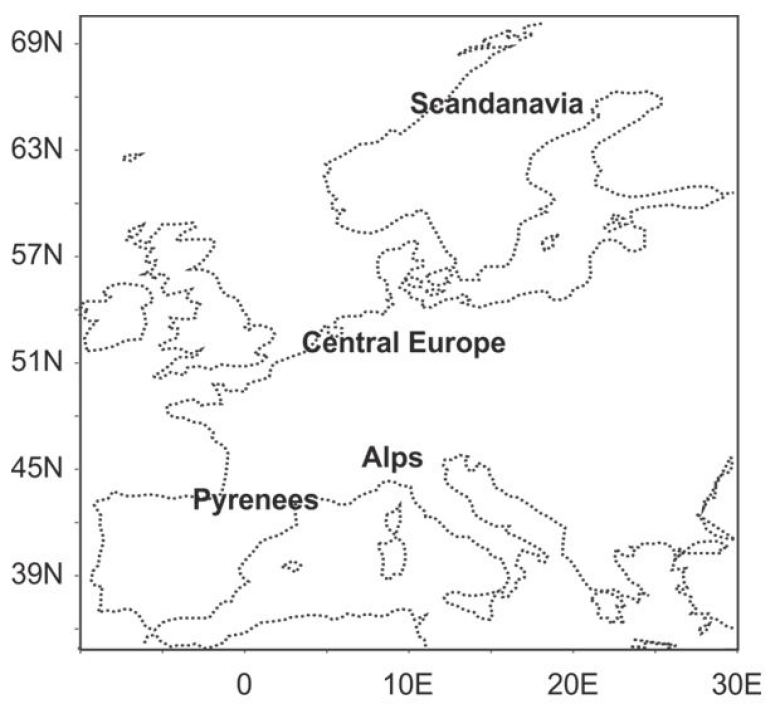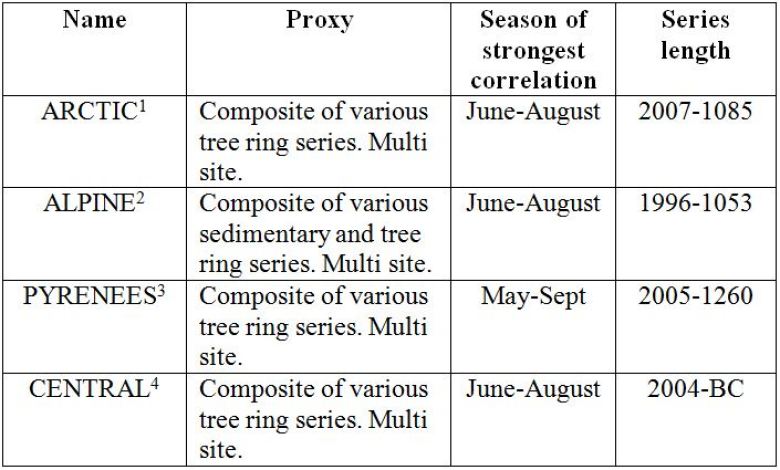Paleoclimate – Learning from the Past
The future lies in the past. This statement may sound technically incorrect or, at best, like a paradox. For some scientists it is, however, one hundred percent accurate. They unlock insights from events that have already taken place in order to uncover what could happen to us in the future. These scientists include members of Dr Eduardo Zorita's "Paleoclimatology and Statistics" working group in the Department of Systems Analysis and Modelling at the Institute of Coastal Research. They investigate periods in the past to better understand the “here and now”.
But what exactly does “paleo” mean? What periods are we talking about? What conclusions can be drawn from the past? And was everything better in the past in regard to climate? Above all, what are paleoclimatologists working with exactly?
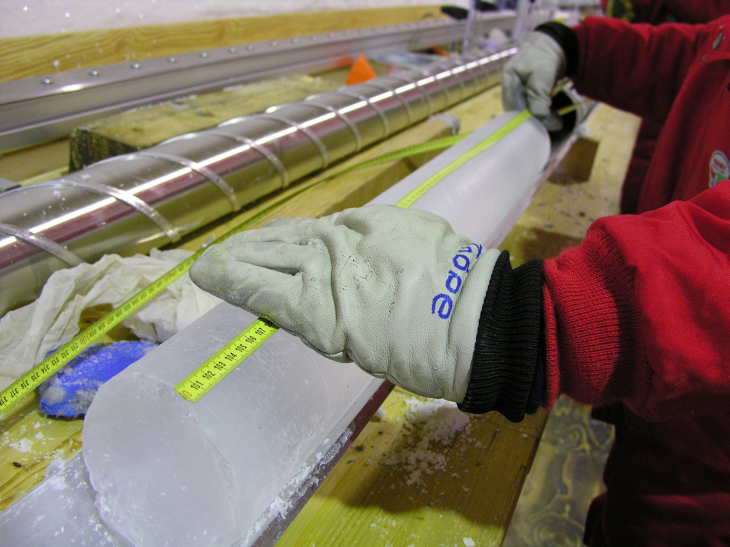
Scientist working with ice cores. Much insight about past climate can be discovered from these ice cores. (Photo: Hans Oerter/AWI)
In 2016, the term “paleo” without the addition of “climate” provides search engine results mainly on the subject of nutrition, more specifically on the "paleo diet”. The fashionable trend for modern nutrition aiming to resemble that of “the past” is not addressed here, but the origin of the term’s meaning is investigated. “Paleo" is short for the Paleolithic, the Old Stone Age. It describes both the earliest and longest epoch of the Stone Age that begins between one and two million years ago, lasting until approximately twelve thousand years ago. According to our current understanding, a particular type of climate existed on Earth during each period. If we designate climate as a weather statistic over long time periods lasting at least thirty years, a constant change can be seen that is based on both natural and, in at least the last one hundred years or so, anthropogenic influences.
The Constantly Changing Climate
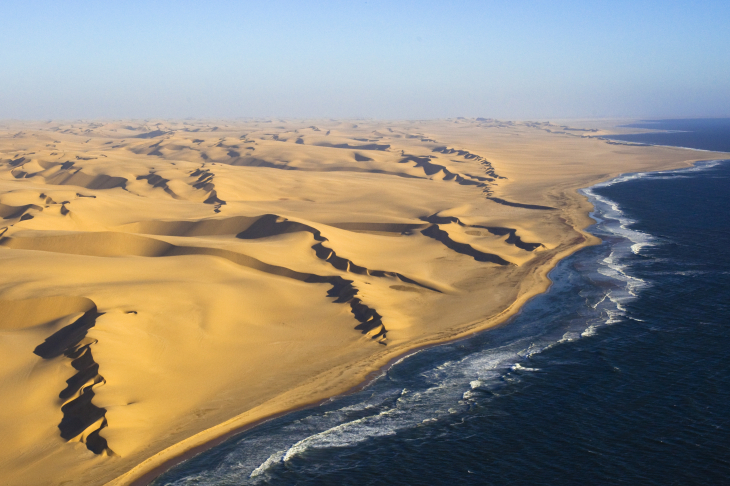
Namibian Desert (Photo: cdca beckoetter/Fotolia)
Climate is therefore not a static condition, but always a process. Natural climate variability is thereby caused by interactions between the rather chaotic reacting atmosphere and the rather sluggishly responding ocean. Simply stated, climate changes in the long-term over hundreds of thousands or millions of years (for example, through variations of the Earth's orbit and the Earth's plate tectonics) just as it does over a few years to decades (through the solar cycle, volcanic eruptions or through the anthropogenic contribution of the greenhouse effect). What portions of these time periods typically belong to paleoclimatology?
While today weather records of temperature, precipitation and air pressure are mainly carried out using instruments in order to determine time series for climate statistics, paleoclimatology is involved with investigating climate during periods before the widespread availability of these recordings. Dr Sebastian Wagner from the working group “Paleoclimatology and Statistics” finds the last one thousand years of paleoclimate research particularly interesting “because the time period facilitates insights into climate before human influence on a global scale and the period is relatively well-covered by climate records—both in quantity and quality of the data.”
Reconstructing Climate Through Proxy and Model Data
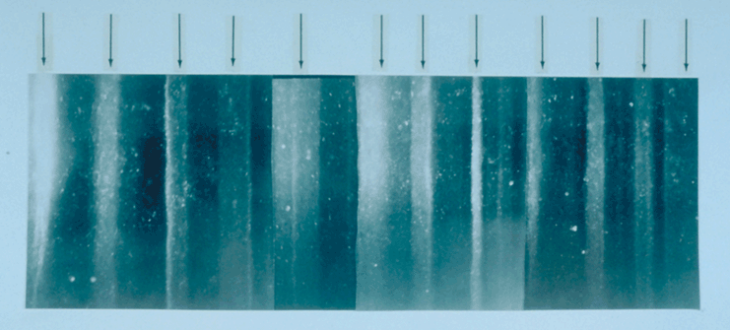
Ice core layers. (Photo: Greenland Ice Sheet Project 2 /GISP2)
Because the thermometer hadn't been invented yet and therefore no records of temperature from a thousand years ago exist, scientists under the leadership of Dr Eduardo Zorita must turn to other means. Past climate reconstruction is essentially undertaken in two ways:
> 1. The empirical reconstruction based on proxy data. These are provided, for example, by tree rings, ice cores, corals, stalactites/stalagmites and sea sediments. In addition – mainly for populated areas - historical records come into play. Such documents contain information about crop yields or distinctive flood marks. Ship logs are also consulted for analysis, serving as early weather diaries.
> 2. Reconstruction with the help of climate models. What is known as external forcing data is fed into the models pertaining, for example, to volcanic events, solar activity and information on green house gasses, which were, until the era of industrialisation, mostly of natural origin and barely influenced by anthropogenic activities. Models supply a spatially consistent image of potential climate changes of the past. The HZG scientists calculate global simulations (with the Earth system model MPI-ESM-P from the Max Planck Institute for Meteorology) as well as regional studies (with the regional model COSMO-CCLM from the "Regional Atmospheric Modelling" working group at the Institute of Coastal Research).
A Modelled Volcanic Eruption
It sounds complicated to place a highly complex world into a simplified model. This, however, is not so difficult using the most plausible theories and basing the model on physical assumptions. How does one, for example, explain a volcanic eruption with the help of a climate model?
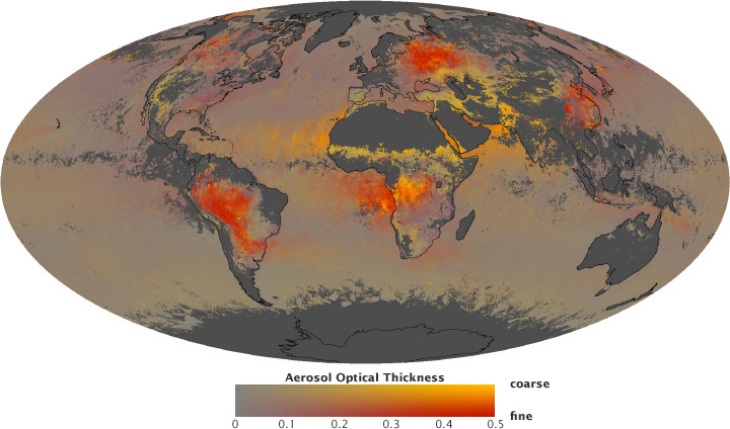
The occurrence of aerosols in the atmosphere, caused by volcanic eruptions that change the optical density (aerosol optical depth). (Photo: GERICS)
In order to do so, certain parameters are “tinkered with”, similar to the way I would on a music mixer: If I want my musical instrument to sound more powerful and deeper, I alter the bass channels. If I wish to instead accentuate higher, more sensitive tones, I vary the influence of the tenor range. When a volcano erupts, you change what is known as the optical density (aerosol optical depth) in a climate model. In simple terms, this quantity describes the intensity of light shining through a medium.
More precisely: In the real world, the volcano causes an eruption in a specific location, while the resulting aerosols can be distributed around the world. In the model, the values for the change in optical density are therefore prescribed for a total of four latitudinal bands. Based on the measured sulphate quantity in the ice core, the character of the eruption can be assessed using an algorithm. Any reconstructed volcanic eruption can now be reproduced in this manner, taking its temporal progression into account. The substrate concentration, or more precisely, the pH value from the ice core enables us to draw conclusions on the strength of the eruption.

An ice core in a core trough is reflected several times in the aluminium surfaces. (Photo: Sepp Kipfstuhl/HZG)
Researching past climate can be exciting and informative in all respects. Nevertheless, the question arises as to what extent this work leads to insights that are relevant for today or for the future. On the one hand, according to Dr Sebastian Wagner, the study of past climates is important for obtaining information about the breadth of variations under natural conditions. He says, “In addition, the current climate models offer us the opportunity to reflect findings derived from empirical data in climate epochs that are clearly different from the climate of today.”
Probabilities and Statistics
But how reliably can past events actually be determined? We must again remember the information that is fed into the climate models. For simulating the climate of the last one to two thousand years, the scientists integrate information into the climate model: changes in the Earth's orbital parameters, solar activity, volcanism and greenhouse gas concentrations as well as distinctive changes in land use. All parameters have a different relevance. “The most reliable reconstructions are of the Earth’s orbital parameters because they can be derived from celestial mechanics,” explains Dr Eduardo Zorita. Solar and volcanic activity, however, can only be determined with great uncertainty because they are derived from proxy data mentioned above, Zorita points out. Similarly difficult to examine are the land use changes because they must first be derived through model applications, which also are already based on certain approximations. On the other hand, researchers recognize the changes in greenhouse gas concentrations in the air relatively easily. For this purpose, the ice cores help them, which have stored the respective conditions quite well in the their air pockets.
Publications in Nature and Nature Geoscience
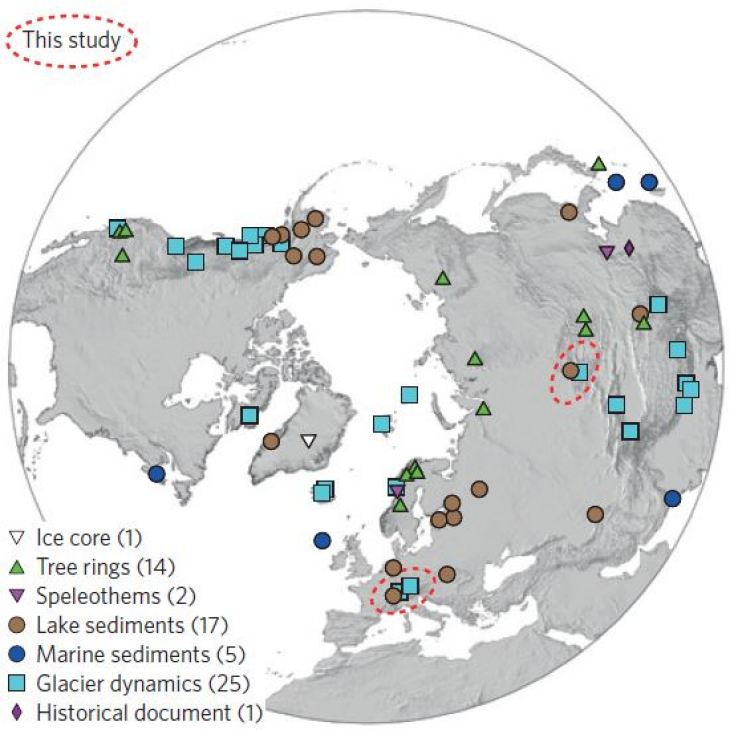
Occurrences of different proxy types in the northern hemisphere. This data makes it possible to draw conclusions about temperature. The figure refers to the cold wave study of the 6th century AD, which resulted in socio-cultural consequences. Presentation: HZG/ Dr. Eduardo Zorita
The scientists in the Paleoclimatology and Statistics working group are currently focused on the climate of the last two thousand years. This era includes the Mediaeval Warm Period, around the year 1000, in which the average temperatures resembled those of the twentieth century. Immediately before and after this period, however, “small ice ages” prevailed. The causes for the temporary and considerably higher global temperatures are not yet well understood. Studies in this area could provide information on whether or how intensely our current climate system could possibly trigger substantial natural variations in a short period of time.
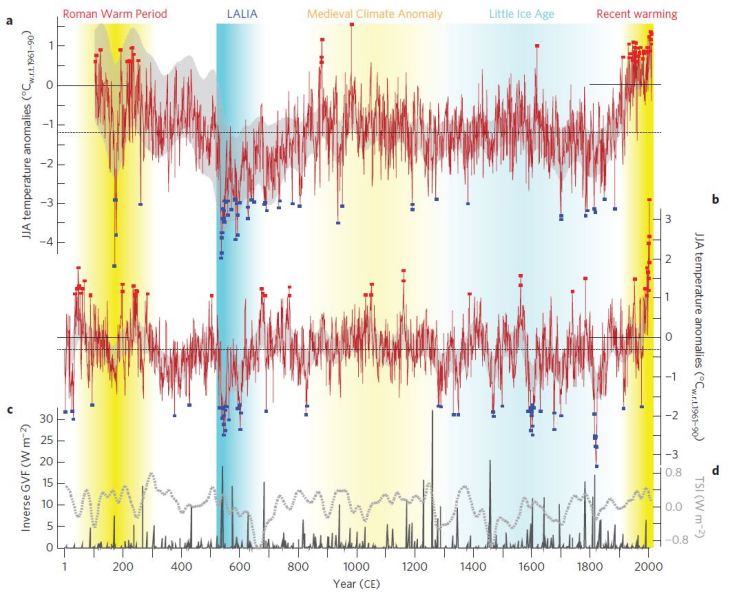
Reconstructed temperature variations in northern European summer months. The Late Antique Little Ice Age (LALIA) began in 536 AD and emerged clearly here (blue shading). (Figure: Ulf Büntgen)
In the academic journal Natural Geoscience, scientists from six European countries and the United States, with the participation of Dr Sebastian Wagner, have detected a distinctive cold period in Eurasia around 600 AD which is also highlighted by extensive disease, mass migrations and political upheavals. The cold period in the 6th century is thus the most pronounced cooling in the northern hemisphere in the last two thousand years. The scientists attribute the cause to three large volcanic eruptions within eleven years, whose effect on the climate was prolonged due to the ocean’s delayed response and minimum solar activity. The results show a connection between climatic changes and their influence on cultural and historical events. This study can be downloaded in its original.
Within the context of large international projects such as Pages2K, climate model data is compared to empirical reconstructions. Likewise, the question arises as to what concrete conclusions can be made using climate simulations for a full glacial-interglacial period of the last 130000 years. Such answers are sought within the PALMOD project, supported by the Federal Ministry of Education and Research (BMBF). Dr Eduardo Zorita’s working group participates in one of the sub-projects.
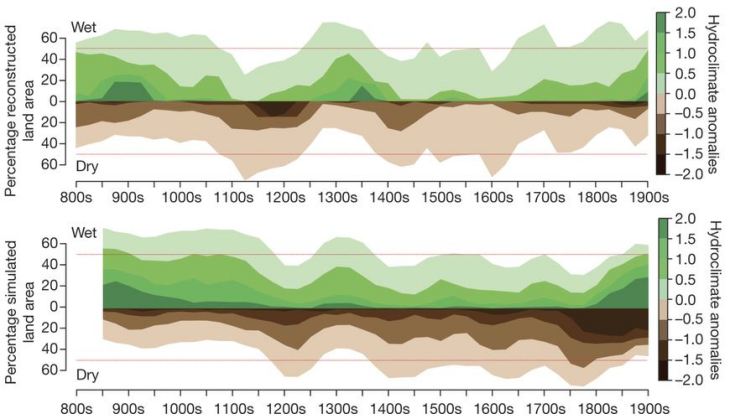
Derived hydoclimate anomalies relative to the average for the millennium selected. Above: values from proxy data. Below: values from climate simulations. Presentation: HZG/ Dr. Eduardo Zorita
In the scientific journal Nature, Zorita and his colleagues from Sweden and Switzerland reconstructed the hydroclimate (humidity and drought in connection with temperature) of the northern hemisphere for the last 1200 years based on proxy data. According to this reconstruction, the dry periods in the subtropics frequently coincided with considerably more humid phases in higher latitudes and vice versa. Regional dry events in the American Midwest, however, were not necessarily connected to high temperatures. The proxy data used for this study thus did not provide a clear connection between hydroclimate and temperature development. The scientists compared the statistics with model simulations. The conclusion was that there was strong agreement for the pre-industrial period which was not the case for the 20th century. Here the average hydroclimate anomalies from the simulations were not supported by the reconstruction using the proxy data. This study can also be read in its detailed original.
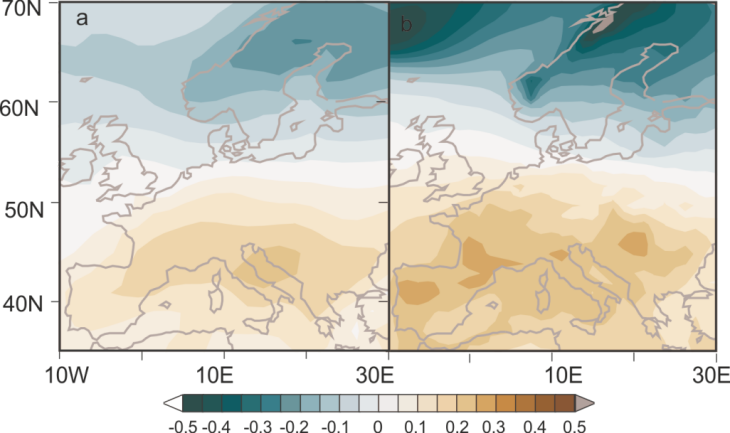
Surface temperature deviations in European summer months (JJA) with regard to the average in the area. Left: Simulations with the MPI-ESM-P model Right: Simulations with the CCSM4 model. Presentation: HZG/ Dr. Eduardo Zorita
Another paper was published just a few days ago in which HZG scientists participated. Zorita and his colleagues from Great Britain showed that the North Atlantic storm tracks over Europe are solely determined by what is known as internal climate variability. This includes natural processes within the climate system such as interaction between the atmosphere and the ocean or between the ground layers and the biosphere. One example is the El Niño phenomenon during which the surface temperatures in a portion of the Pacific significantly increases. This change in the sea surface temperatures subsequently effects the atmospheric circulation. Such events thus contribute to the fact that storm systems follow certain paths over northern Europe. External forcings such as greenhouse gases, solar radiation and volcanic eruptions or anthropogenic influences have played no part, at least not in the last centuries. This study was also published in the academic journal Nature Geoscience and can be accessed online.
Paleoclimatology is, for the most part, interdisciplinary. Empirical reconstructions are often carried out by geologists and biologists, while the climate simulations are frequently undertaken by physicists, computer scientists or mathematicians. Those who wish to study Earth climate of the past take courses in the classical fields of geosciences. Working in paleoclimatology also requires knowledge and interest in programming and statistics.
Scientific publications
FURTHER INFORMATION
Contact

Department of Paleoclimatology and Statistics
Phone: +49 (0)4152 87-1856
E-mail contact

